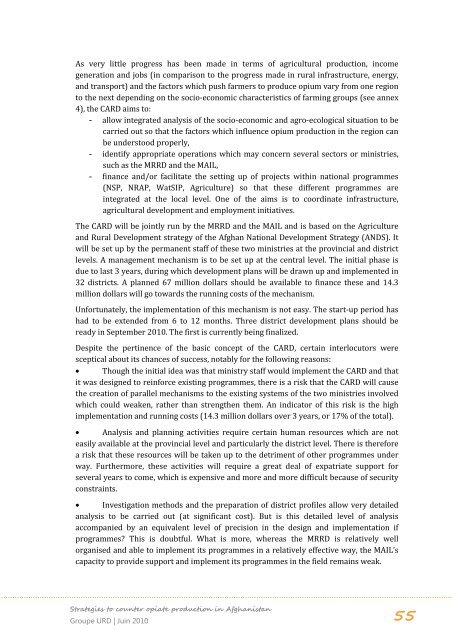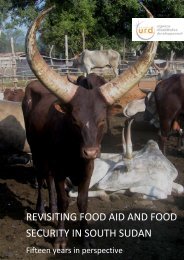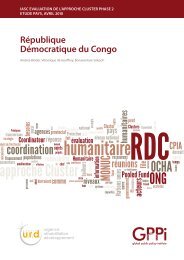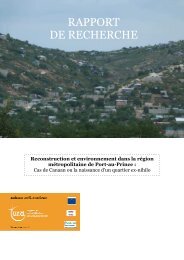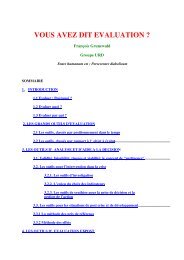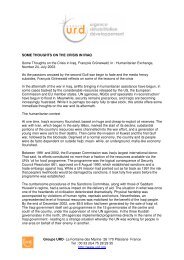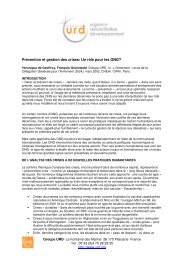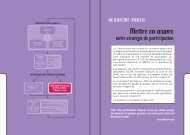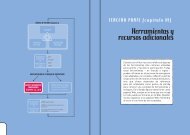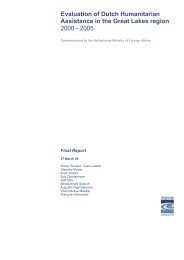strategies to counter opiate in Afghanistan - Groupe URD
strategies to counter opiate in Afghanistan - Groupe URD
strategies to counter opiate in Afghanistan - Groupe URD
Create successful ePaper yourself
Turn your PDF publications into a flip-book with our unique Google optimized e-Paper software.
As very little progress has been made <strong>in</strong> terms of agricultural production, <strong>in</strong>come<br />
generation and jobs (<strong>in</strong> comparison <strong>to</strong> the progress made <strong>in</strong> rural <strong>in</strong>frastructure, energy,<br />
and transport) and the fac<strong>to</strong>rs which push farmers <strong>to</strong> produce opium vary from one region<br />
<strong>to</strong> the next depend<strong>in</strong>g on the socio-economic characteristics of farm<strong>in</strong>g groups (see annex<br />
4), the CARD aims <strong>to</strong>:<br />
- allow <strong>in</strong>tegrated analysis of the socio-economic and agro-ecological situation <strong>to</strong> be<br />
carried out so that the fac<strong>to</strong>rs which <strong>in</strong>fluence opium production <strong>in</strong> the region can<br />
be unders<strong>to</strong>od properly,<br />
- identify appropriate operations which may concern several sec<strong>to</strong>rs or m<strong>in</strong>istries,<br />
such as the MRRD and the MAIL,<br />
- f<strong>in</strong>ance and/or facilitate the sett<strong>in</strong>g up of projects with<strong>in</strong> national programmes<br />
(NSP, NRAP, WatSIP, Agriculture) so that these different programmes are<br />
<strong>in</strong>tegrated at the local level. One of the aims is <strong>to</strong> coord<strong>in</strong>ate <strong>in</strong>frastructure,<br />
agricultural development and employment <strong>in</strong>itiatives.<br />
The CARD will be jo<strong>in</strong>tly run by the MRRD and the MAIL and is based on the Agriculture<br />
and Rural Development strategy of the Afghan National Development Strategy (ANDS). It<br />
will be set up by the permanent staff of these two m<strong>in</strong>istries at the prov<strong>in</strong>cial and district<br />
levels. A management mechanism is <strong>to</strong> be set up at the central level. The <strong>in</strong>itial phase is<br />
due <strong>to</strong> last 3 years, dur<strong>in</strong>g which development plans will be drawn up and implemented <strong>in</strong><br />
32 districts. A planned 67 million dollars should be available <strong>to</strong> f<strong>in</strong>ance these and 14.3<br />
million dollars will go <strong>to</strong>wards the runn<strong>in</strong>g costs of the mechanism.<br />
Unfortunately, the implementation of this mechanism is not easy. The start-up period has<br />
had <strong>to</strong> be extended from 6 <strong>to</strong> 12 months. Three district development plans should be<br />
ready <strong>in</strong> September 2010. The first is currently be<strong>in</strong>g f<strong>in</strong>alized.<br />
Despite the pert<strong>in</strong>ence of the basic concept of the CARD, certa<strong>in</strong> <strong>in</strong>terlocu<strong>to</strong>rs were<br />
sceptical about its chances of success, notably for the follow<strong>in</strong>g reasons:<br />
• Though the <strong>in</strong>itial idea was that m<strong>in</strong>istry staff would implement the CARD and that<br />
it was designed <strong>to</strong> re<strong>in</strong>force exist<strong>in</strong>g programmes, there is a risk that the CARD will cause<br />
the creation of parallel mechanisms <strong>to</strong> the exist<strong>in</strong>g systems of the two m<strong>in</strong>istries <strong>in</strong>volved<br />
which could weaken, rather than strengthen them. An <strong>in</strong>dica<strong>to</strong>r of this risk is the high<br />
implementation and runn<strong>in</strong>g costs (14.3 million dollars over 3 years, or 17% of the <strong>to</strong>tal).<br />
• Analysis and plann<strong>in</strong>g activities require certa<strong>in</strong> human resources which are not<br />
easily available at the prov<strong>in</strong>cial level and particularly the district level. There is therefore<br />
a risk that these resources will be taken up <strong>to</strong> the detriment of other programmes under<br />
way. Furthermore, these activities will require a great deal of expatriate support for<br />
several years <strong>to</strong> come, which is expensive and more and more difficult because of security<br />
constra<strong>in</strong>ts.<br />
• Investigation methods and the preparation of district profiles allow very detailed<br />
analysis <strong>to</strong> be carried out (at significant cost). But is this detailed level of analysis<br />
accompanied by an equivalent level of precision <strong>in</strong> the design and implementation if<br />
programmes This is doubtful. What is more, whereas the MRRD is relatively well<br />
organised and able <strong>to</strong> implement its programmes <strong>in</strong> a relatively effective way, the MAIL’s<br />
capacity <strong>to</strong> provide support and implement its programmes <strong>in</strong> the field rema<strong>in</strong>s weak.<br />
Strategies <strong>to</strong> <strong>counter</strong> <strong>opiate</strong> production <strong>in</strong> <strong>Afghanistan</strong><br />
<strong>Groupe</strong> <strong>URD</strong> | Ju<strong>in</strong> 2010<br />
55


